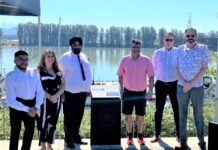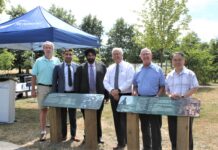
BY NAVEEN GIRN
IN the middle of the night, on July 19, 1914, Canadian Immigration officials and a hastily arranged volunteer militia launched a midnight attack on the Komagata Maru. What later became known as “The Great Hindu War” or “The Battle of Burrard Inlet” is one of the most iconic moments while the ship was moored in Vancouver. While the outcome of the battle is clear, who can claim victory is still in doubt.
The Komagata Maru towered over the police boats and from their superior height, the passengers were able to rain down a barrage of projectiles at the Immigration officials. From the distance of a century, the events of that night are still shrouded in mystery. Eyewitness accounts of the encounter do exist in the Royal British Columbia Museum’s Oral History Archives however some are filled with misinformation and errors. More than an “accurate” recording of events, what they do provide is a glimpse of the perception of the midnight skirmish in popular imagination. In the early 1970’s, Fred “Cyclone” Taylor – Canadian Immigration Official and Vancouver Millionaires Stanley Cup champion– shared this account with historian Vera Rosebluth. She begins by asking what the feelings of the passengers were like after being stranded for close to two months:
Vera Rosenbluth: Did the mood change?
Fred Taylor: Definitely. Very definitely. They got discouraged as any crew would. Take 300 Canadians locked up in a port of entry for 3 -4 weeks. Their mood would change naturally. But it didn’t change to that extent that there was going to be any demand or any attempt to go ashore cause they couldn’t do it. They realized they couldn’t do it.
VR: The Saturday night when police went out?
FT: Well, I would say this boat that went out on the Saturday night would be oh… after they’d been here about a month. The men were getting quite dissatisfied and we – the inspector Mr. Reid and Mr. Stevens and our lawyer Mr. Robby Reid, together with Mr. Bird their lawyer had decided to go out to the boat and have a confab, unfortunately we allowed a number of our friends to go out – it was a lovely Saturday night- just to have a look around. And for some reason or another, as our boat got right along side the Komagata Maru, somebody either aboard or on of the Komagata Maru fired a revolver off. Now, the East Indians I know, felt that that shot had come from our boat. And in the excitement we didn’t know where it had come from. With that, they decided, the East Indians decided to pay us back in some respect and they started throwing lumps of coal down onto our tug. Well naturally the men who were nearest the boat came over and our tug was packed with visitors which we should never had allowed. And they all went to one side. And to this day I don’t know why that boat didn’t capsize. And then we would’ve been in the middle of Burrard inlet in the dark of night and it would have been a catastrophe really.
 Taylor is wrong about how long the ship was docked in Burrard Inlet when the attack took place but his comments about the friends coming along, belies a forgotten aspect of the Komagata Maru story: the ship was a spectacle. Archival photographs do not show a ship isolated in the Inlet. Instead it was under a 24 hour patrol by immigration ships and – most importantly- pleasure crafts and private boats were able to sail up to the ship and gawk at the passengers and hurl racial insults. Stranded on the ship and unable to gain any respite, the passengers endured this treatment for weeks.
Taylor is wrong about how long the ship was docked in Burrard Inlet when the attack took place but his comments about the friends coming along, belies a forgotten aspect of the Komagata Maru story: the ship was a spectacle. Archival photographs do not show a ship isolated in the Inlet. Instead it was under a 24 hour patrol by immigration ships and – most importantly- pleasure crafts and private boats were able to sail up to the ship and gawk at the passengers and hurl racial insults. Stranded on the ship and unable to gain any respite, the passengers endured this treatment for weeks.
Taylor also tries to minimize the concerted, pre-meditated nature of attack. But knowledge of it was known ahead of time as highlighted in journalist Charlie Shaw’s recollection:
“You’ve probably heard about the Great Hindu War in BC? Well, I was on the coast when it happened, too. Oh gee, for several weeks there I was foreman of a little newspaper in New Westminster and we got through about 3 o’ clock in the morning and we’d wind up and get the paper to bed as we called it and a bunch of us would jump on a late interurban and go over there and to see the police fight these Hindus. Over in Vancouver. To see the ship. They came in on a Japanese liner! And uh, harboured, they were anchored out in the harbour and they wouldn’t let the…. the immigration people said that Ottawa said they had to let them in because they were British subjects. At that time India belonged to Great Britain you see. And (laughs) the police said we don’t care if they’re British or not we don’t want them. So they turned each one back as undesireable. Individually. Not as “the Hindus” you see what I mean? So they finally got the navy to get them out. Called the base at Esquimalt. And they had a Destroyer come over there and these fellows went in with bayonets. And they escorted the ship. BC won out alright.”
 One reason for the attack was the failure the Munshi Singh trial. After being moored in Burrard Inlet for almost two months, the Canadian Immigration officials finally allowed a “test case”. The Komagata Maru passengers and their lawyer selected passenger Munshi Singh and presumably if he were allowed to enter Canada, the rest of passengers would be allowed to enter as well. From the beginning the odds were stacked against Munshi Singh and the Canadian government had learned from its mistakes with the Panama Maru the year earlier and made sure to close any loopholes in the Continuous Journey Regulation. The test cast was lost. Days later the ship was attacked.
One reason for the attack was the failure the Munshi Singh trial. After being moored in Burrard Inlet for almost two months, the Canadian Immigration officials finally allowed a “test case”. The Komagata Maru passengers and their lawyer selected passenger Munshi Singh and presumably if he were allowed to enter Canada, the rest of passengers would be allowed to enter as well. From the beginning the odds were stacked against Munshi Singh and the Canadian government had learned from its mistakes with the Panama Maru the year earlier and made sure to close any loopholes in the Continuous Journey Regulation. The test cast was lost. Days later the ship was attacked.
By late July, the Komagata Maru passengers were in dire straits. They were running critically out of food, water, and other provisions; their lawyer J. Edward Bird had received death threats and left Vancouver; and after their defeat in Burrard Inlet, the Canadian government called in the naval warship HMCS Rainbow from Esquimalt. The British Columbia Regiment was also mobilized in a show of strength against the passengers. As Vancouver resident Harriet Parker remembered, ”it seemed as if it was the beginning of the War, it seemed when that started. And my daughter Joan’s first words were “Eyes right” because we used to have a regiment drilling in front of our house and this sergeant would march up and down and yell “Eyes right”’.
The belief that the Komagata Maru was a German conspiracy to overthrow the British Empire is more reflective of what came afterwards. The Great War was to begin in September and the Komagata Maru came to be seen in some minds as a precursor to that event. Although there are no direct connections between the Komagata Maru passengers and a German conspiracy, many of the passengers were arrested, jailed and put under surveillance for the remainder of World War One once they returned to India. Even esteemed author Sir Arthur Conan Doyle used his skills of deduction to determine why “sun loving Hindus” would want to come to Canada. His answer was a German plot.
 One missing element of the archival oral history of the Komagata Maru is the lack of South Asian voices who could provide an alternative side to the story. In researching his book The Voyage of the Komagata Maru scholar Hugh Johnston interviewed Kartar Singh – a Komagata Maru passenger who finally set foot on Canadian soil in the 1970s. By this time he was in his 90s and Singh recalled the day that the HMCS Rainbow pointed its guns at the Komagata Maru and ordered the ship to leave. He mentions a state of panic and fear among some passengers who were continually running below deck to pray in the makeshift gurdwara set up inside the ship. But there were also some passengers who had brought musical instruments with them and a large contingent banded together on the deck and – directly in front of the battleship- they played and sang heroic ballads and folk songs to bolster their courage.
One missing element of the archival oral history of the Komagata Maru is the lack of South Asian voices who could provide an alternative side to the story. In researching his book The Voyage of the Komagata Maru scholar Hugh Johnston interviewed Kartar Singh – a Komagata Maru passenger who finally set foot on Canadian soil in the 1970s. By this time he was in his 90s and Singh recalled the day that the HMCS Rainbow pointed its guns at the Komagata Maru and ordered the ship to leave. He mentions a state of panic and fear among some passengers who were continually running below deck to pray in the makeshift gurdwara set up inside the ship. But there were also some passengers who had brought musical instruments with them and a large contingent banded together on the deck and – directly in front of the battleship- they played and sang heroic ballads and folk songs to bolster their courage.
A reporter for The Province newspaper found out about Kartar Singh’s arrival and got him and Fred “Cyclone” Taylor in a room to take a picture. The sentiment of the picture is one of old adversaries meeting as friends. However, it’s disingenuous to think that historical traumas can be tied up in neat little bows. Whether it’s the necessity of collecting more community stories to balance the biases and silences that currently exist in our archives, or the need to have learning material, exhibitions, and online resources for students who want to learn more about the Komagata Maru the legacies of these major moments are still with us today. Continuing the dialogue beyond the strict confines of the anniversary date is imperative in making these stories part of our nation’s story and connecting it to present day injustices that need to be overcome.
Naveen Girn is the Project Manager for “Komagata Maru 1914-2014: Generations, Geographies and Echoes” featuring a group of 8 institutions across Metro Vancouver collaboratively commemorating the 100th anniversary of the Komagata Maru Episode (www.komagatamaru100.com)












